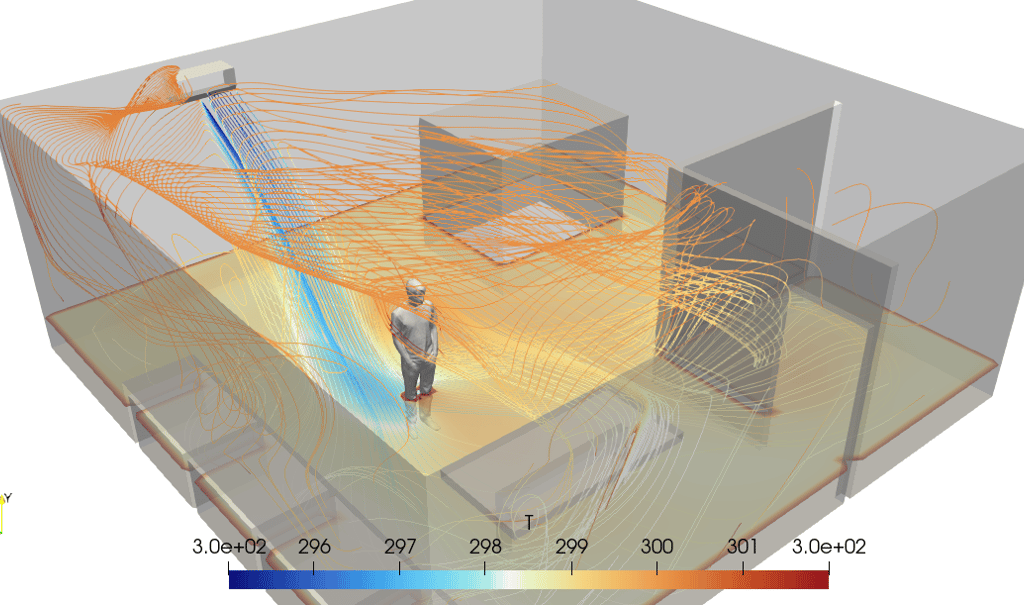HVAC flow and thermal design for Comfort and indoor air quality
HVAC Design Optimization: Evaluating Air Age, Velocity, Temperature, DR, PMV, and PPD Distributions
ARTICLES
wiratama
10/9/20253 min read


1. Introduction
In modern building design, Heating, Ventilation, and Air Conditioning (HVAC) systems play a critical role in achieving thermal comfort, energy efficiency, and indoor air quality. Beyond the conventional parameters of temperature and airflow rate, advanced computational simulations—such as Computational Fluid Dynamics (CFD)—enable detailed analysis of air age, velocity fields, temperature gradients, and comfort indices like Draft Rate (DR), Predicted Mean Vote (PMV), and Predicted Percentage of Dissatisfied (PPD). These metrics provide a deeper understanding of how HVAC systems perform across different zones of a building.
2. Air Age: Understanding Freshness of Air
Air age represents the time elapsed since air entered the ventilated space. It quantifies ventilation effectiveness and identifies zones where air may stagnate, leading to poor air quality.
Younger air age indicates efficient ventilation and faster replacement of stale air.
Older air age highlights dead zones, often caused by poor diffuser placement or insufficient mixing.
In CFD studies, tracer gas or scalar transport equations are used to simulate air age distribution. Designers can use this data to reposition diffusers or adjust supply velocities to improve air renewal.
3. Air Velocity: Comfort and Distribution
Air velocity within an occupied zone affects both comfort and thermal mixing.
Low velocities (<0.1 m/s) may lead to stratification and uneven temperature distribution.
High velocities (>0.3 m/s) can cause drafts and discomfort.
HVAC design aims to maintain velocity within the ASHRAE 55 recommended limits. CFD visualization of velocity vectors and streamlines helps identify recirculation areas and optimize diffuser angles and outlet geometry.
4. Temperature Distribution: Avoiding Stratification
Temperature uniformity is crucial for occupant comfort and system efficiency. Uneven temperature gradients may arise from poor air mixing, equipment heat loads, or solar radiation effects.
Thermal stratification occurs when warm air accumulates near the ceiling while cooler air remains at the floor level.
CFD temperature contours help designers evaluate how supply air temperature and diffuser placement influence thermal balance across occupied zones.
5. Draft Rate (DR): Quantifying Airflow-Induced Discomfort
Draft Rate (DR) predicts the percentage of occupants dissatisfied due to unwanted air movement and low temperature in localized zones. It is a function of local velocity fluctuations, air temperature, and turbulence intensity. CFD tools can calculate DR at occupant height (typically 1.1 m for seated persons) to identify discomfort zones.
6. PMV and PPD: Thermal Comfort Evaluation
The Predicted Mean Vote (PMV) and Predicted Percentage of Dissatisfied (PPD) indices, developed by Fanger, are standard measures of thermal comfort defined in ISO 7730 and ASHRAE 55.
PMV estimates the average thermal sensation of a large group of people based on metabolic rate, clothing insulation, air temperature, mean radiant temperature, air velocity, and humidity.
PPD predicts the percentage of people likely to feel thermally uncomfortable.
Typical acceptable comfort range:
PMV: between -0.5 and +0.5
PPD: less than 10%
CFD simulation coupled with comfort models allows designers to map PMV and PPD across the building, ensuring both thermal comfort and energy optimization.
7. Integrated Performance Visualization
By combining air age, velocity, temperature, DR, PMV, and PPD in a single 3D CFD post-processing framework, engineers can:
Assess ventilation efficiency and comfort distribution.
Identify regions of discomfort or stagnation.
Optimize HVAC diffuser layout and supply conditions.
For example:
A low-velocity zone with high air age indicates poor ventilation.
A region with PMV > +0.7 may suggest excessive heating or insufficient air mixing.
High DR regions near diffusers could be mitigated by adjusting air supply angles.
8. Conclusion
Advanced HVAC design is no longer limited to achieving setpoint temperatures. By leveraging CFD analysis of air age, velocity, temperature distribution, and comfort indices (DR, PMV, PPD), engineers can design ventilation systems that balance thermal comfort, air quality, and energy efficiency. Such simulation-driven design ensures that occupants experience uniform comfort while minimizing energy waste—key principles in sustainable building engineering.
Software to simulate Indoor Comfort and Air Quality
tensorHVAC-Pro is a software dedicated for indoor comfort and Air Quality of a HVAC system, designed for easy to use even for non simulation expert, focus on your project success.

